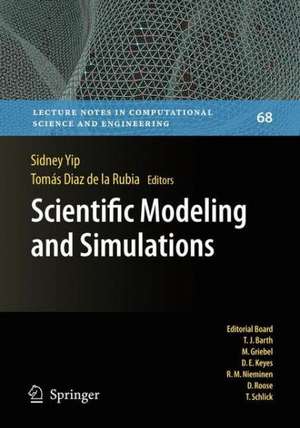Scientific Modeling and Simulations: Lecture Notes in Computational Science and Engineering, cartea 68
Editat de Sidney Yip, Tomas Diaz Rubiaen Limba Engleză Hardback – 11 mar 2009
| Toate formatele și edițiile | Preț | Express |
|---|---|---|
| Paperback (1) | 559.92 lei 38-44 zile | |
| SPRINGER NETHERLANDS – 21 oct 2010 | 559.92 lei 38-44 zile | |
| Hardback (1) | 656.43 lei 6-8 săpt. | |
| SPRINGER NETHERLANDS – 11 mar 2009 | 656.43 lei 6-8 săpt. |
Din seria Lecture Notes in Computational Science and Engineering
-
 Preț: 375.63 lei
Preț: 375.63 lei - 18%
 Preț: 1247.70 lei
Preț: 1247.70 lei - 18%
 Preț: 787.15 lei
Preț: 787.15 lei -
 Preț: 384.31 lei
Preț: 384.31 lei - 20%
 Preț: 990.95 lei
Preț: 990.95 lei - 15%
 Preț: 648.56 lei
Preț: 648.56 lei - 15%
 Preț: 653.00 lei
Preț: 653.00 lei -
 Preț: 405.28 lei
Preț: 405.28 lei - 18%
 Preț: 976.06 lei
Preț: 976.06 lei - 18%
 Preț: 968.82 lei
Preț: 968.82 lei -
 Preț: 397.97 lei
Preț: 397.97 lei - 18%
 Preț: 962.49 lei
Preț: 962.49 lei - 15%
 Preț: 647.08 lei
Preț: 647.08 lei - 15%
 Preț: 648.56 lei
Preț: 648.56 lei - 15%
 Preț: 649.54 lei
Preț: 649.54 lei - 18%
 Preț: 1389.30 lei
Preț: 1389.30 lei -
 Preț: 428.30 lei
Preț: 428.30 lei - 18%
 Preț: 1240.62 lei
Preț: 1240.62 lei - 20%
 Preț: 666.27 lei
Preț: 666.27 lei - 15%
 Preț: 654.43 lei
Preț: 654.43 lei - 15%
 Preț: 644.30 lei
Preț: 644.30 lei - 18%
 Preț: 957.62 lei
Preț: 957.62 lei - 18%
 Preț: 1224.18 lei
Preț: 1224.18 lei - 18%
 Preț: 904.11 lei
Preț: 904.11 lei - 18%
 Preț: 1242.83 lei
Preț: 1242.83 lei - 20%
 Preț: 992.11 lei
Preț: 992.11 lei - 15%
 Preț: 642.83 lei
Preț: 642.83 lei - 18%
 Preț: 954.45 lei
Preț: 954.45 lei - 18%
 Preț: 783.20 lei
Preț: 783.20 lei - 18%
 Preț: 949.42 lei
Preț: 949.42 lei - 15%
 Preț: 642.83 lei
Preț: 642.83 lei - 18%
 Preț: 964.86 lei
Preț: 964.86 lei - 18%
 Preț: 1260.83 lei
Preț: 1260.83 lei - 15%
 Preț: 650.37 lei
Preț: 650.37 lei
Preț: 656.43 lei
Preț vechi: 772.26 lei
-15% Nou
Puncte Express: 985
Preț estimativ în valută:
125.61€ • 131.48$ • 104.55£
125.61€ • 131.48$ • 104.55£
Carte tipărită la comandă
Livrare economică 31 martie-14 aprilie
Preluare comenzi: 021 569.72.76
Specificații
ISBN-13: 9781402097409
ISBN-10: 1402097409
Pagini: 408
Ilustrații: VI, 402 p.
Dimensiuni: 155 x 235 x 29 mm
Greutate: 0.86 kg
Ediția:2009
Editura: SPRINGER NETHERLANDS
Colecția Springer
Seria Lecture Notes in Computational Science and Engineering
Locul publicării:Dordrecht, Netherlands
ISBN-10: 1402097409
Pagini: 408
Ilustrații: VI, 402 p.
Dimensiuni: 155 x 235 x 29 mm
Greutate: 0.86 kg
Ediția:2009
Editura: SPRINGER NETHERLANDS
Colecția Springer
Seria Lecture Notes in Computational Science and Engineering
Locul publicării:Dordrecht, Netherlands
Public țintă
ResearchCuprins
Scientific Modeling and Simulations.- A retrospective on the journal of computer-aided materials design (JCAD), 1993–2007.- Extrapolative procedures in modelling and simulations: the role of instabilities.- Characteristic quantities and dimensional analysis.- Accuracy of models.- Multiscale simulations of complex systems: computation meets reality.- Chemomechanics of complex materials: challenges and opportunities in predictive kinetic timescales.- Tight-binding Hamiltonian from first-principles calculations.- Atomistic simulation studies of complex carbon and silicon systems using environment-dependent tight-binding potentials.- First-principles modeling of lattice defects: advancing our insight into the structure-properties relationship of ice.- Direct comparison between experiments and computations at the atomic length scale: a case study of graphene.- Shocked materials at the intersection of experiment and simulation.- Calculations of free energy barriers for local mechanisms of hydrogen diffusion in alanates.- Concurrent design of hierarchical materials and structures.- Enthalpy landscapes and the glass transition.- Advanced modulation formats for fiber optic communication systems.- Computational challenges in the search for and production of hydrocarbons.- Microscopic mechanics of biomolecules in living cells.- Enveloped viruses understood via multiscale simulation: computer-aided vaccine design.- Computational modeling of brain tumors: discrete, continuum or hybrid?.
Textul de pe ultima copertă
The conceptualization of a problem (modeling) and the computational solution of this problem (simulation), is the foundation of Computational Science. This coupled endeavor is unique in several respects. It allows practically any complex system to be analyzed with predictive capability by invoking the multiscale paradigm—linking unit-process models at lower length (or time) scales where fundamental principles have been established to calculations at the system level.
The community of multiscale materials modeling has evolved into a multidisciplinary group with a number of identified problem areas of interest. Sidney Yip and Tomas Diaz De La Rubia, the editors of this volume, have gathered 18 contributions that showcase the conceptual advantages of modeling which, coupled with the unprecedented computing power through simulations, allow scientists to tackle the formibable problems of our society, such as the search for hydrocarbons, understanding the structure of a virus, or the intersection between simulations and real data in extreme environments.
Scientific Modeling and Simulations advocates the scientific virtues of modeling and simulation, and also encourages the cross fertilization between communities, exploitations of high-performance computing, and experiment-simulation synergies.
The contents of this book were previously published in Scientific Modeling and Simulations, Vol 15, No. 1-3, 2008.
The community of multiscale materials modeling has evolved into a multidisciplinary group with a number of identified problem areas of interest. Sidney Yip and Tomas Diaz De La Rubia, the editors of this volume, have gathered 18 contributions that showcase the conceptual advantages of modeling which, coupled with the unprecedented computing power through simulations, allow scientists to tackle the formibable problems of our society, such as the search for hydrocarbons, understanding the structure of a virus, or the intersection between simulations and real data in extreme environments.
Scientific Modeling and Simulations advocates the scientific virtues of modeling and simulation, and also encourages the cross fertilization between communities, exploitations of high-performance computing, and experiment-simulation synergies.
The contents of this book were previously published in Scientific Modeling and Simulations, Vol 15, No. 1-3, 2008.
Caracteristici
Showcases cutting-edge applications of modeling and computations to formidable research problems relevant to our society. Highlights the benefits of cross-fertilization between computational science and other research communities. Includes supplementary material: sn.pub/extras










